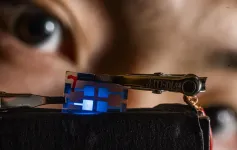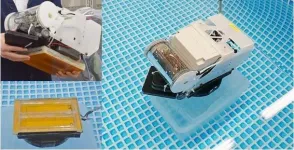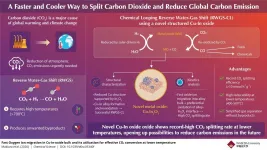(Press-News.org) Researchers at Linköping University, Sweden, have developed efficient blue light-emitting diodes based on halide perovskites. "We are very excited about this breakthrough", says Feng Gao, professor at Linköping University. The new LEDs may open the way to cheap and energy-efficient illumination.
Illumination is responsible for approximately 20% of global electricity consumption, a figure that could be reduced to 5% if all light sources consisted of light-emitting diodes (LEDs). The blue-white LEDs currently in use, however, need complicated manufacturing methods and are expensive, which makes it more difficult to achieve a global transition.
LEDs manufactured from halide perovskites could be a cheaper and more eco-friendly alternative for both illumination and LED-based monitors. Perovskites are a family of semiconducting materials defined by their cubic crystal structure. They have good light-emitting properties and are easy to manufacture. Using elements from the halogen group, i.e. fluorine, chlorine, bromine and iodine, perovskites can be given properties that depend on the chemical composition of the crystal.
LEDs for green and red light have already been created with perovskites, but one colour, blue, has so far been lacking, making it impossible to achieve white light.
"Blue light is the key to bringing light-emitting perovskites to practical applications. Our most recent breakthrough is one step on the way", says Feng Gao, professor at the Department of Physics, Chemistry and Biology at Linköping University.
Feng Gao's research group, in collaboration with colleagues in Lund, Great Britain, Germany, China and Denmark, has managed to create halide perovskites that give stable emission in the wavelength range 451-490 nanometres - corresponding to deep blue to sky blue colours. Max Karlsson is doctoral student at Linköping University and joint first author of the article now published in Nature Communications. He says:
"Metal-halide perovskites are easily colour-tuneable over the whole visible spectrum by simple alloying. Unfortunately, they exhibit demixing and a blue LED turns green during operation. We have found a method that can prevent this colour shift by controlling the film crystallisation dynamics when creating the perovskite. These findings pave the way for stable perovskite alloys, not only for LEDs but also for solar cells."
The challenge of creating blue light in perovskites is that it requires a chemical composition with a large fraction of chloride, which makes the perovskite unstable. Blue perovskite-based LEDs have previously been created with using what is known as the "quantum confinement technique", which gives low-intensity LEDs with poor efficiency. However, stable perovskites with the desired amount of chloride can be created with the aid of the "vapour-assisted crystallisation technique". Furthermore, the Linköping University researchers have achieved an energy efficiency of up to 11% for the blue perovskite-based LEDs.
"We have shown that blue light-emitting diodes based on halide perovskites can be both efficient and stable across a broad spectrum, without using quantum confinement. We have managed to create one of the most efficient blue perovskite-based LEDs so far known", says Weidong Xu, postdoc at Linköping University.
The science of perovskites is a relatively new research field that has aroused major international interest, since it offers a great potential for developing cheap and efficient materials. Feng Gao, however, is quick to point out that the work they have done is basic research, and applications are still some way off in future.
"Perovskite LEDs are a young technology and have some way to go before they see the light of day. Currently, the short lifetime and poor performance of blue LEDs are the main obstacles for perovskite light-emitting diodes before they can start to compete with existing technologies such as light-emitting diodes based on organic and inorganic semiconductors. We will keep working on that to make PeLEDs comparable to the other technologies", says Feng Gao.
INFORMATION:
Sources of research finance include an ERC Starting Grant, the Swedish Research Council, the Swedish Energy Agency, and through the Swedish Strategic Research Area in Advanced Functional Materials (AFM) at Linköping University.
The article:
Mixed Halide Perovskites for Spectrally Stable and High-Efficiency Blue Light-Emitting Diodes
Max Karlsson, Ziyue Yi, Sebastian Reichert, Xiyu Luo, Weihua Lin, Zeyu Zhang, Chunxiong Bao, Rui Zhang, Sai Bai, Guanhaojie Zheng, Pengpeng Teng, Lian Duan, Yue Lu, Kaibo Zheng, Tönu Pullerits, Carsten Deibel, Weidong Xu, Richard Friend, and Feng Gao. Nature Communications 2021. DOI: 10.1038/s41467-020-20582-6
Atomic nuclei are held together by the strong interaction between neutrons and protons. About ten percent of all known nuclei are stable. Starting from these stable isotopes, nuclei become increasingly unstable as neutrons are added or removed, until neutrons can no longer bind to the nucleus and "drip" out. This limit of existence, the so-called neutron "dripline", has so far been discovered experimentally only for light elements up to neon. Understanding the neutron dripline and the structure of neutron-rich nuclei also plays a key role in the research program for the future accelerator facility FAIR at the GSI Helmholtz Centre for Heavy Ion Research in Darmstadt.
In a new study, "Ab Initio Limits of Nuclei," ...
The levels of small molecules called microRNAs (miRNAs) circulating in blood could help identify early on children with life-threatening forms of malaria, according to a study led by the Barcelona Institute for Global Health, an institution supported by "la Caixa" Foundation, in collaboration with the Manhiça Health Research Center (CISM) in Mozambique. The results, published in Emerging Infectious Diseases journal, could also help better understand the mechanisms underlying severe malaria.
Malaria mortality among young African children remains unacceptably high. To improve the outcome, it is important to rapidly identify and treat children with severe forms of the disease. ...
Overview:
Associate professor Masaya Tamura, Kousuke Murai (who has completed the first term of his master's program), and their research team from the Department of Electrical and Electronic Information Engineering at Toyohashi University of Technology have successfully transferred power and data wirelessly through seawater by using a power transmitter/receiver with four layers of ultra-thin, flat electrodes. In the field of wireless power transfers, seawater behaves as a dielectric with extremely high loss, and achievement through capacitive coupling is difficult. Up until now, it had been thought that wireless power transfers could only be achieved through magnetic coupling. ...
Researchers from the University of Seville and the University of Pavia have identified a link between Amyotrophic Lateral Sclerosis (ALS) and the accumulation of DNA-RNA hybrids in the genome. The accumulation of these hybrids causes increased genomic damage and boosts genetic instability. This finding will make it possible to better understand the molecular basis of the disease, as well as to propose new solutions to curb it.
Amyotrophic Lateral Sclerosis (ALS) is a neurodegenerative disease of the central nervous system, characterised by progressive degeneration ...
The descendants of regular wild-type bacteria can evolve to survive for a long time on metallic copper surfaces that would usually kill them within a few minutes. An international research team led by Martin Luther University Halle-Wittenberg (MLU) and the Bundeswehr Institute of Microbiology was able to produce these tiny survivalists in the lab and has been able to study them more closely. The team reports on its findings in Applied and Environmental Microbiology.
Bacterial infections are usually treated with antibiotics. However, in recent decades many pathogenic bacteria have developed an increasing tolerance to common drugs. So-called multidrug-resistant bacteria are of particular concern as ...
It is politically agreed and necessary for climate protection reasons that our entire economy becomes climate-neutral in the coming decades - and that applies to air travel, too. This is a technically feasible goal, and there are numerous ways to achieve it. ETH Professor Marco Mazzotti and his team have now compared the options that appear to be the easiest to implement in the short and medium term and evaluated them according to factors such as cost-effectiveness.
The ETH researchers conclude that the most favourable option is to continue powering aircraft with fossil fuels in future, but then remove the associated CO2 emissions from the atmosphere ...
Fuchs' corneal dystrophy is one of the most common eye diseases diagnosed in almost 5% of the population of Europe aged 40 years or over. It is a hereditary eye disease that causes vision impairment and typically manifests in middle age. The first symptoms of the disease - blisters on the surface of your cornea - resemble cataract at first glance. The disease progresses from the centre of the cornea affecting all layers of the cornea. The progression of the disease varies from individual to individual and in severe cases results in vision loss.
The molecular neurobiology ...
With ever-worsening climate change, there is a growing need for technologies that can capture and use up the atmospheric CO2 (carbon dioxide) and reduce our carbon footprint. Within the realm of renewable energy, CO2-based e-fuels have emerged as a promising technology that attempts to convert atmospheric CO2 into clean fuels. The process involves production of synthetic gas or syngas (a mixture of hydrogen and carbon monoxide (CO)). With the help of the reverse water-gas shift (RWGS) reaction, CO2 is broken down into the CO necessary for syngas. While promising in its conversion efficiency, the RWGS reaction requires incredibly high temperatures (>700°C) to proceed, while also generating ...
In a new study, researchers at Karolinska Institutet in Sweden have used a urine test to identify and verify a patient's type of asthma. The study, which has been published in the American Journal of Respiratory and Critical Care Medicine, lays the foundation for a more personalized diagnosis and may result in improved treatment of severe asthma in the future.
About 10 percent of the Swedish population suffers from asthma, a disease that has become increasingly widespread over the past 50 years, with annual global mortality of around 400,000 according to the World Health Organization. Asthma is characterized by chronic inflammation in the airways, which can result in symptoms including ...
In three recent publications in Molecular Psychiatry, Brain and JAMA Neurology researchers from the University of Gothenburg provide convincing evidence that an in-house developed blood test for Alzheimer's disease can detect the disease early and track its course, which has major implications for a potential use in clinical practice and treatment trials.
"This is an extremely dynamic research field right now, thanks to the technological development and seminal scientific progress in the past years. The dream scenario is to have a blood test for the early detection and screening of Alzheimer's disease up and running. That would give significantly ...





